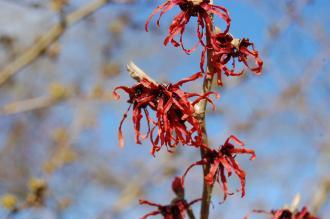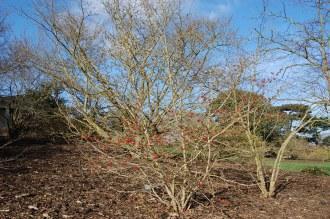
Hamamelis x intermedia ‘Diane’ Flower (08/02/2015, Kew Gardens, London)
Position: Sun to dappled shade
Flowering period: Winter
Soil: Moist, well drained
Eventual Height: 4m
Eventual Spread: 4m
Hardiness: 5a, 5b, 6a, 6b, 7a, 7b, 8a, 8b, 9a
Family: Hamamelidaceae
Hamamelis x intermedia ‘Diane’ is a medium sized, deciduous spreading small tree or large shrub. The light green alternate leaves emerge from short-stalked buds. The leaves are elliptic to nearly circular in shape, irregularly toothed along their edges and become a yellow/ red in autumn. Some of the autumn leaves are retained on this tree through the winter months. Its red flowers appear in clusters. Its petals are long, thin and crinkled. The fruit is a two part capsule. It is usually grafted onto the rootstock of one of the other species of Hamamelis.
Hamamelis x intermedia ‘Diane’ is commonly known as the Hybrid Witch Hazel Diane. The species is a hybrid between Hamamelis mollis and Hamamelis japonica. Subjective research has been carried out on the relative fragrance and leaf retention of various Hamamelis species and varieties by the curators of Scott Arboretum.
The etymological root of the binomial name Hamamelis is derived from the Greek amamelis ‘a tree with pear like fruits’. Intermedia is derived from the Latin inter meaning ‘between’ and medius meaning ‘middle’ in reference to this hybrid being between its two parents in terms of characteristics.
The landscape architect may find Hamamelis x intermedia ‘Diane’ useful in dappled shade locations as a small tree with attractive winter flowers and autumn leaf color.

Hamamelis x intermedia ‘Diane’ (08/02/2015, Kew Gardens, London)
Ecologically, Hamamelis x intermedia ‘Diane’ flowers attract members of the Lepidoptera family which includes butterflies and moths.
The Royal Horticultural Society has given Hamamelis x intermedia ‘Diane’ their prestigious Award of Garden Merit in 1993.
Hamamelis x intermedia ‘Diane’ prefers moist, fertile, well-drained soils. It tolerates most pH of soil, although it prefers neutral to acidic soils.
Hamamelis x intermedia ‘Diane’ requires little maintenance.

